Comprehensive Report: Travel and Tourism Sector Analysis and Impact
VerifiedAdded on 2020/12/29
|11
|3744
|237
Report
AI Summary
This report provides a comprehensive analysis of the travel and tourism sector, encompassing historical developments, the structure of the industry, and the functions of government and international agencies. It examines the influence of national and local policies on the sector's success, including economic and political impacts, such as the effects of political changes and policy decisions. The report also delves into the factors affecting tourism demand, including economic conditions, time, and seasons, and how changes in demand are met through various services and supply chain management. Furthermore, it explores the positive and negative economic, environmental, and social impacts of tourism and discusses strategies to mitigate the negative effects. The report emphasizes the interconnectedness of various elements within the sector and provides a well-rounded view of the challenges and opportunities in the travel and tourism industry.
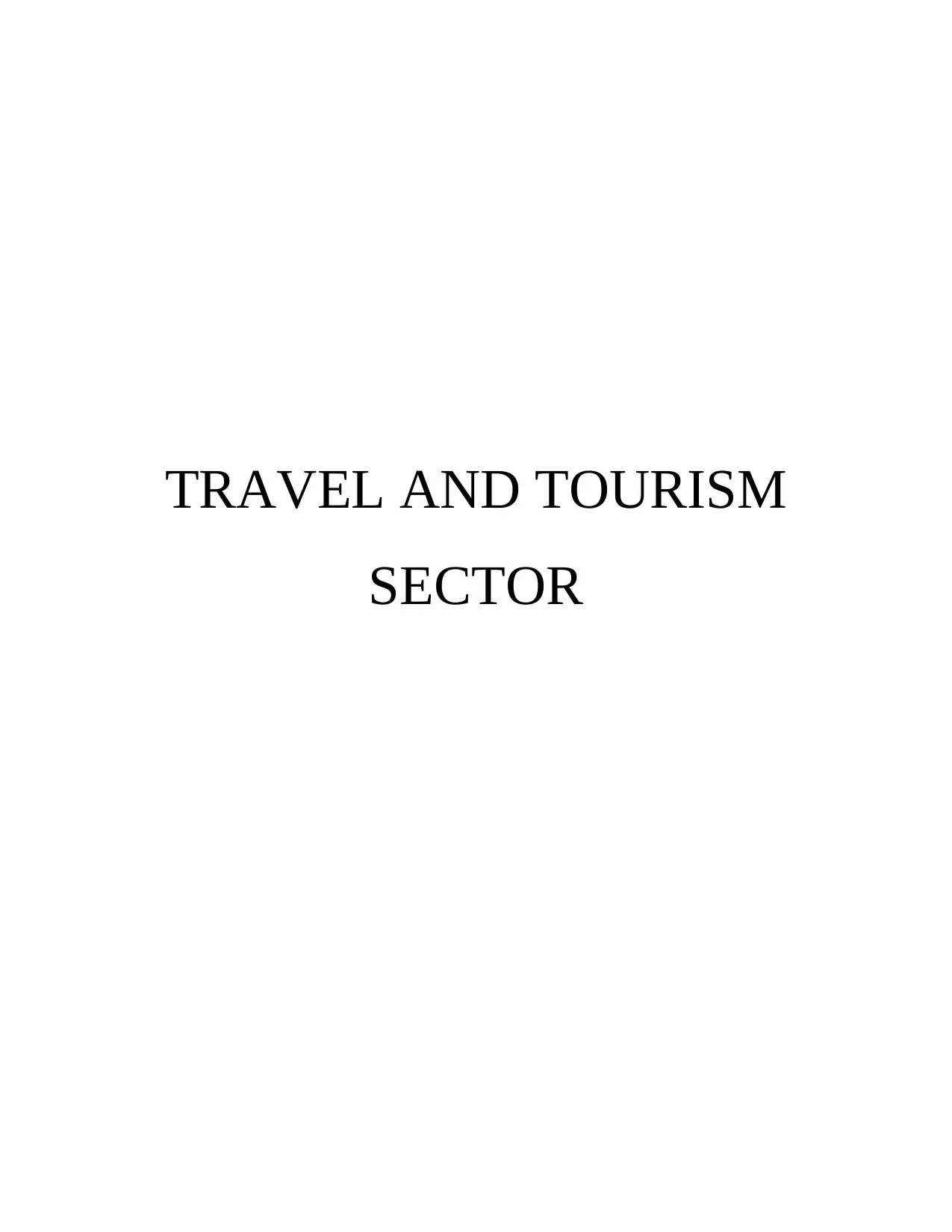
TRAVEL AND TOURISM
SECTOR
SECTOR
Paraphrase This Document
Need a fresh take? Get an instant paraphrase of this document with our AI Paraphraser
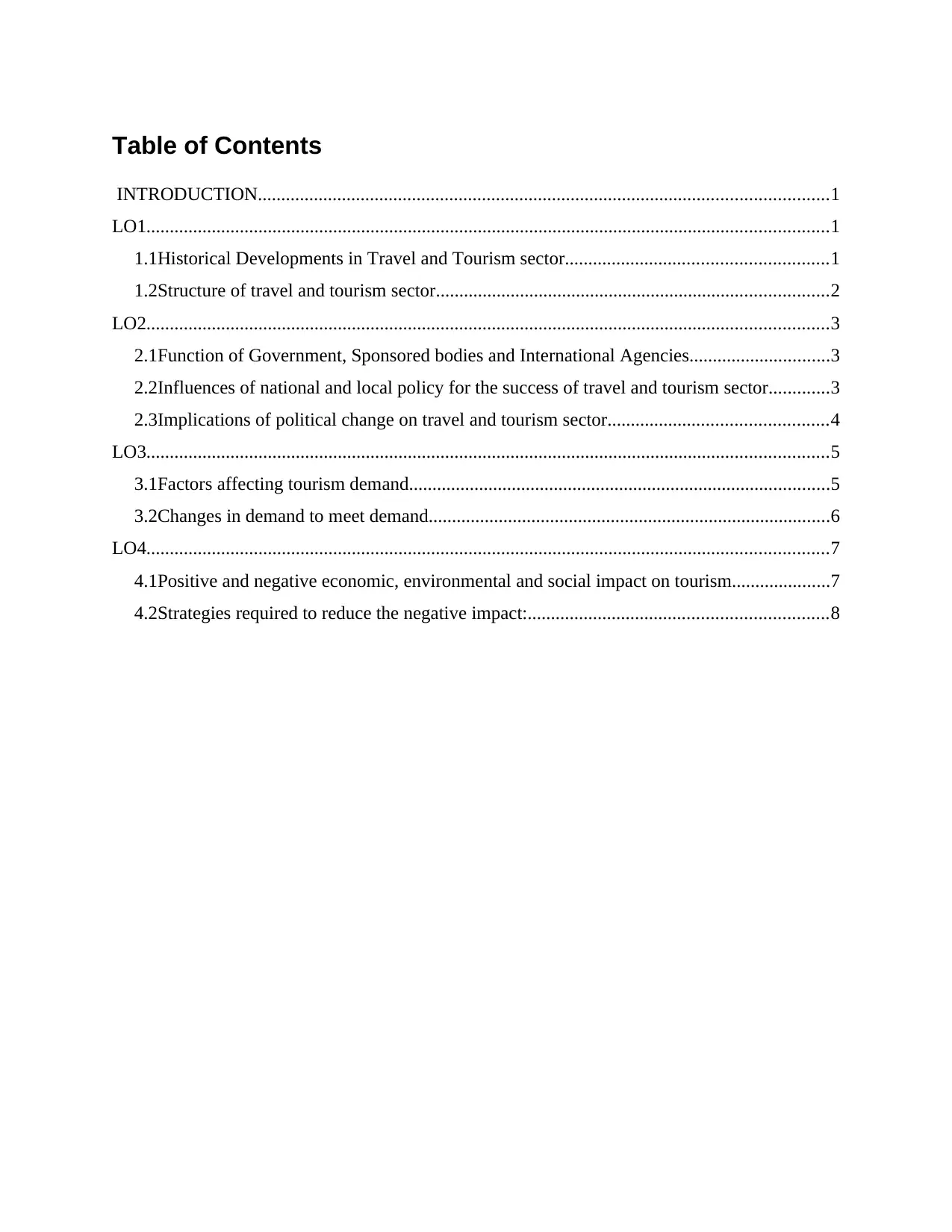
Table of Contents
INTRODUCTION..........................................................................................................................1
LO1..................................................................................................................................................1
1.1Historical Developments in Travel and Tourism sector........................................................1
1.2Structure of travel and tourism sector....................................................................................2
LO2..................................................................................................................................................3
2.1Function of Government, Sponsored bodies and International Agencies..............................3
2.2Influences of national and local policy for the success of travel and tourism sector.............3
2.3Implications of political change on travel and tourism sector...............................................4
LO3..................................................................................................................................................5
3.1Factors affecting tourism demand..........................................................................................5
3.2Changes in demand to meet demand......................................................................................6
LO4..................................................................................................................................................7
4.1Positive and negative economic, environmental and social impact on tourism.....................7
4.2Strategies required to reduce the negative impact:................................................................8
INTRODUCTION..........................................................................................................................1
LO1..................................................................................................................................................1
1.1Historical Developments in Travel and Tourism sector........................................................1
1.2Structure of travel and tourism sector....................................................................................2
LO2..................................................................................................................................................3
2.1Function of Government, Sponsored bodies and International Agencies..............................3
2.2Influences of national and local policy for the success of travel and tourism sector.............3
2.3Implications of political change on travel and tourism sector...............................................4
LO3..................................................................................................................................................5
3.1Factors affecting tourism demand..........................................................................................5
3.2Changes in demand to meet demand......................................................................................6
LO4..................................................................................................................................................7
4.1Positive and negative economic, environmental and social impact on tourism.....................7
4.2Strategies required to reduce the negative impact:................................................................8
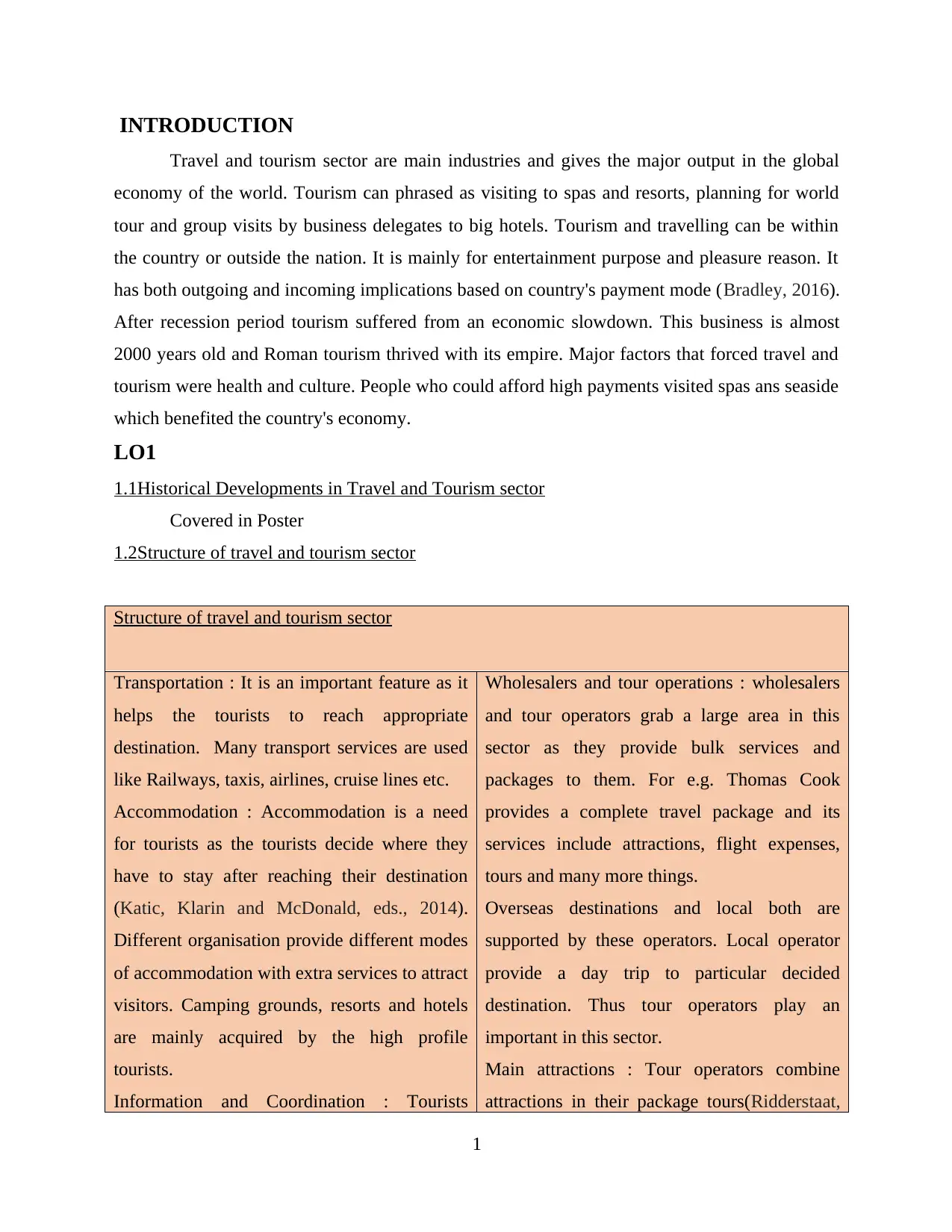
INTRODUCTION
Travel and tourism sector are main industries and gives the major output in the global
economy of the world. Tourism can phrased as visiting to spas and resorts, planning for world
tour and group visits by business delegates to big hotels. Tourism and travelling can be within
the country or outside the nation. It is mainly for entertainment purpose and pleasure reason. It
has both outgoing and incoming implications based on country's payment mode (Bradley, 2016).
After recession period tourism suffered from an economic slowdown. This business is almost
2000 years old and Roman tourism thrived with its empire. Major factors that forced travel and
tourism were health and culture. People who could afford high payments visited spas ans seaside
which benefited the country's economy.
LO1
1.1Historical Developments in Travel and Tourism sector
Covered in Poster
1.2Structure of travel and tourism sector
Structure of travel and tourism sector
Transportation : It is an important feature as it
helps the tourists to reach appropriate
destination. Many transport services are used
like Railways, taxis, airlines, cruise lines etc.
Accommodation : Accommodation is a need
for tourists as the tourists decide where they
have to stay after reaching their destination
(Katic, Klarin and McDonald, eds., 2014).
Different organisation provide different modes
of accommodation with extra services to attract
visitors. Camping grounds, resorts and hotels
are mainly acquired by the high profile
tourists.
Information and Coordination : Tourists
Wholesalers and tour operations : wholesalers
and tour operators grab a large area in this
sector as they provide bulk services and
packages to them. For e.g. Thomas Cook
provides a complete travel package and its
services include attractions, flight expenses,
tours and many more things.
Overseas destinations and local both are
supported by these operators. Local operator
provide a day trip to particular decided
destination. Thus tour operators play an
important in this sector.
Main attractions : Tour operators combine
attractions in their package tours(Ridderstaat,
1
Travel and tourism sector are main industries and gives the major output in the global
economy of the world. Tourism can phrased as visiting to spas and resorts, planning for world
tour and group visits by business delegates to big hotels. Tourism and travelling can be within
the country or outside the nation. It is mainly for entertainment purpose and pleasure reason. It
has both outgoing and incoming implications based on country's payment mode (Bradley, 2016).
After recession period tourism suffered from an economic slowdown. This business is almost
2000 years old and Roman tourism thrived with its empire. Major factors that forced travel and
tourism were health and culture. People who could afford high payments visited spas ans seaside
which benefited the country's economy.
LO1
1.1Historical Developments in Travel and Tourism sector
Covered in Poster
1.2Structure of travel and tourism sector
Structure of travel and tourism sector
Transportation : It is an important feature as it
helps the tourists to reach appropriate
destination. Many transport services are used
like Railways, taxis, airlines, cruise lines etc.
Accommodation : Accommodation is a need
for tourists as the tourists decide where they
have to stay after reaching their destination
(Katic, Klarin and McDonald, eds., 2014).
Different organisation provide different modes
of accommodation with extra services to attract
visitors. Camping grounds, resorts and hotels
are mainly acquired by the high profile
tourists.
Information and Coordination : Tourists
Wholesalers and tour operations : wholesalers
and tour operators grab a large area in this
sector as they provide bulk services and
packages to them. For e.g. Thomas Cook
provides a complete travel package and its
services include attractions, flight expenses,
tours and many more things.
Overseas destinations and local both are
supported by these operators. Local operator
provide a day trip to particular decided
destination. Thus tour operators play an
important in this sector.
Main attractions : Tour operators combine
attractions in their package tours(Ridderstaat,
1
⊘ This is a preview!⊘
Do you want full access?
Subscribe today to unlock all pages.

Trusted by 1+ million students worldwide
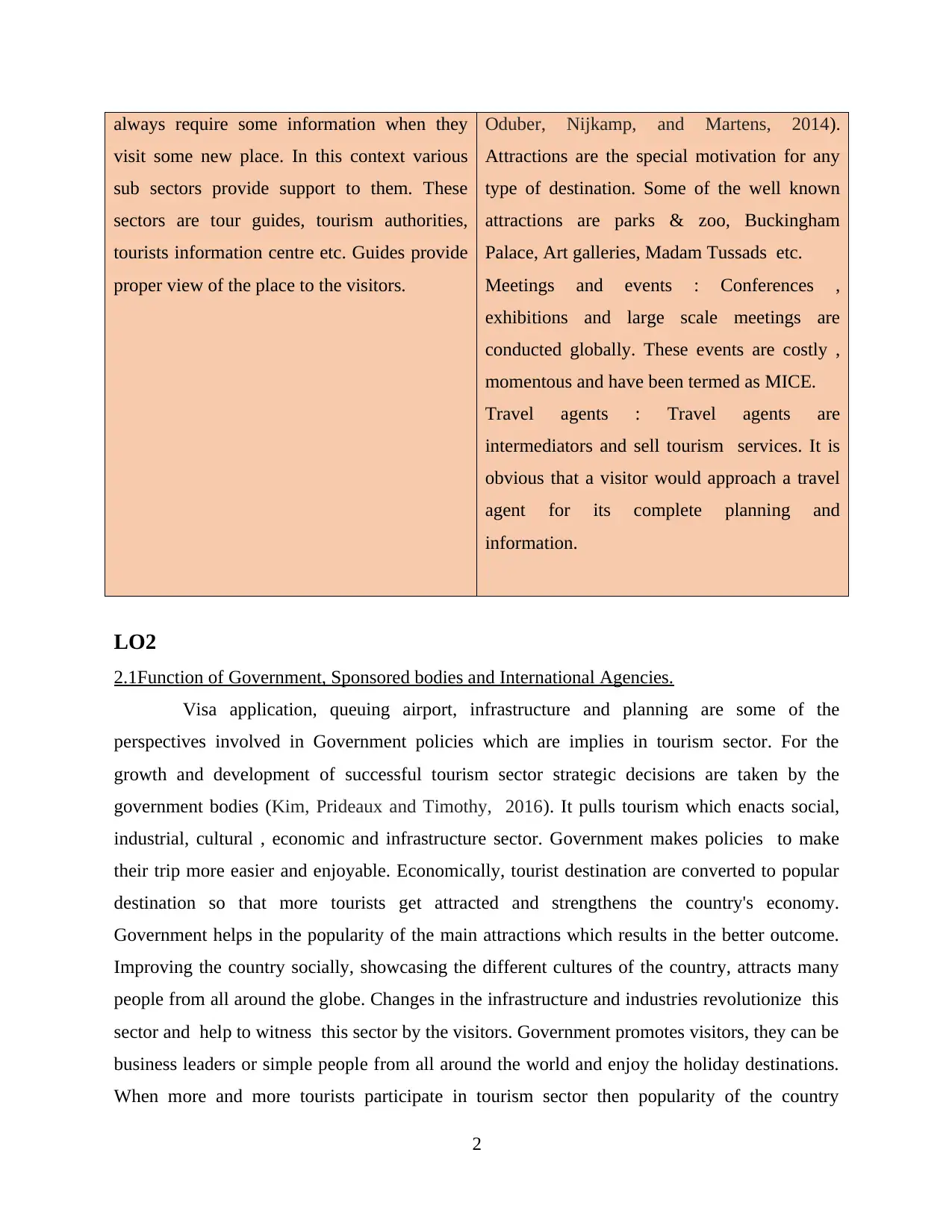
always require some information when they
visit some new place. In this context various
sub sectors provide support to them. These
sectors are tour guides, tourism authorities,
tourists information centre etc. Guides provide
proper view of the place to the visitors.
Oduber, Nijkamp, and Martens, 2014).
Attractions are the special motivation for any
type of destination. Some of the well known
attractions are parks & zoo, Buckingham
Palace, Art galleries, Madam Tussads etc.
Meetings and events : Conferences ,
exhibitions and large scale meetings are
conducted globally. These events are costly ,
momentous and have been termed as MICE.
Travel agents : Travel agents are
intermediators and sell tourism services. It is
obvious that a visitor would approach a travel
agent for its complete planning and
information.
LO2
2.1Function of Government, Sponsored bodies and International Agencies.
Visa application, queuing airport, infrastructure and planning are some of the
perspectives involved in Government policies which are implies in tourism sector. For the
growth and development of successful tourism sector strategic decisions are taken by the
government bodies (Kim, Prideaux and Timothy, 2016). It pulls tourism which enacts social,
industrial, cultural , economic and infrastructure sector. Government makes policies to make
their trip more easier and enjoyable. Economically, tourist destination are converted to popular
destination so that more tourists get attracted and strengthens the country's economy.
Government helps in the popularity of the main attractions which results in the better outcome.
Improving the country socially, showcasing the different cultures of the country, attracts many
people from all around the globe. Changes in the infrastructure and industries revolutionize this
sector and help to witness this sector by the visitors. Government promotes visitors, they can be
business leaders or simple people from all around the world and enjoy the holiday destinations.
When more and more tourists participate in tourism sector then popularity of the country
2
visit some new place. In this context various
sub sectors provide support to them. These
sectors are tour guides, tourism authorities,
tourists information centre etc. Guides provide
proper view of the place to the visitors.
Oduber, Nijkamp, and Martens, 2014).
Attractions are the special motivation for any
type of destination. Some of the well known
attractions are parks & zoo, Buckingham
Palace, Art galleries, Madam Tussads etc.
Meetings and events : Conferences ,
exhibitions and large scale meetings are
conducted globally. These events are costly ,
momentous and have been termed as MICE.
Travel agents : Travel agents are
intermediators and sell tourism services. It is
obvious that a visitor would approach a travel
agent for its complete planning and
information.
LO2
2.1Function of Government, Sponsored bodies and International Agencies.
Visa application, queuing airport, infrastructure and planning are some of the
perspectives involved in Government policies which are implies in tourism sector. For the
growth and development of successful tourism sector strategic decisions are taken by the
government bodies (Kim, Prideaux and Timothy, 2016). It pulls tourism which enacts social,
industrial, cultural , economic and infrastructure sector. Government makes policies to make
their trip more easier and enjoyable. Economically, tourist destination are converted to popular
destination so that more tourists get attracted and strengthens the country's economy.
Government helps in the popularity of the main attractions which results in the better outcome.
Improving the country socially, showcasing the different cultures of the country, attracts many
people from all around the globe. Changes in the infrastructure and industries revolutionize this
sector and help to witness this sector by the visitors. Government promotes visitors, they can be
business leaders or simple people from all around the world and enjoy the holiday destinations.
When more and more tourists participate in tourism sector then popularity of the country
2
Paraphrase This Document
Need a fresh take? Get an instant paraphrase of this document with our AI Paraphraser
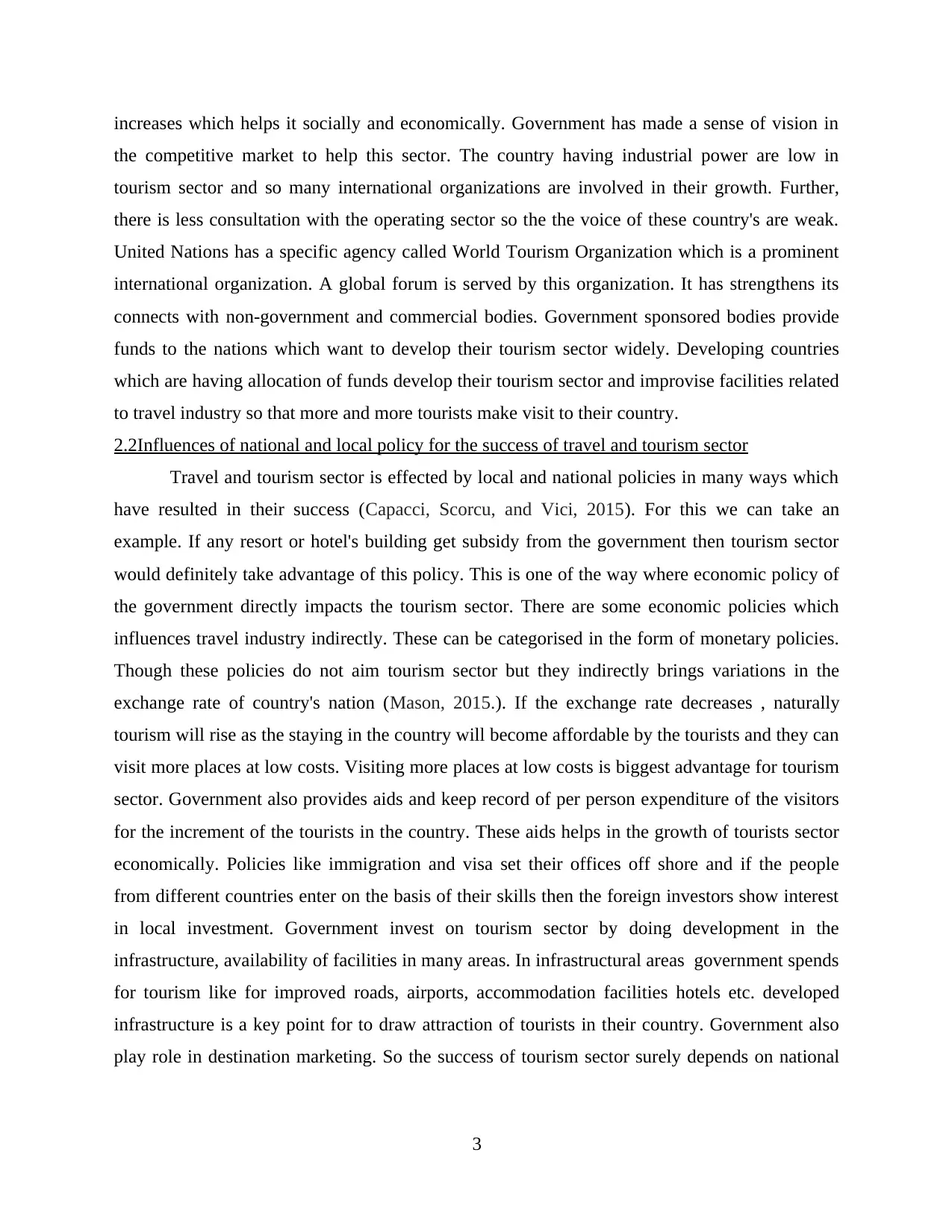
increases which helps it socially and economically. Government has made a sense of vision in
the competitive market to help this sector. The country having industrial power are low in
tourism sector and so many international organizations are involved in their growth. Further,
there is less consultation with the operating sector so the the voice of these country's are weak.
United Nations has a specific agency called World Tourism Organization which is a prominent
international organization. A global forum is served by this organization. It has strengthens its
connects with non-government and commercial bodies. Government sponsored bodies provide
funds to the nations which want to develop their tourism sector widely. Developing countries
which are having allocation of funds develop their tourism sector and improvise facilities related
to travel industry so that more and more tourists make visit to their country.
2.2Influences of national and local policy for the success of travel and tourism sector
Travel and tourism sector is effected by local and national policies in many ways which
have resulted in their success (Capacci, Scorcu, and Vici, 2015). For this we can take an
example. If any resort or hotel's building get subsidy from the government then tourism sector
would definitely take advantage of this policy. This is one of the way where economic policy of
the government directly impacts the tourism sector. There are some economic policies which
influences travel industry indirectly. These can be categorised in the form of monetary policies.
Though these policies do not aim tourism sector but they indirectly brings variations in the
exchange rate of country's nation (Mason, 2015.). If the exchange rate decreases , naturally
tourism will rise as the staying in the country will become affordable by the tourists and they can
visit more places at low costs. Visiting more places at low costs is biggest advantage for tourism
sector. Government also provides aids and keep record of per person expenditure of the visitors
for the increment of the tourists in the country. These aids helps in the growth of tourists sector
economically. Policies like immigration and visa set their offices off shore and if the people
from different countries enter on the basis of their skills then the foreign investors show interest
in local investment. Government invest on tourism sector by doing development in the
infrastructure, availability of facilities in many areas. In infrastructural areas government spends
for tourism like for improved roads, airports, accommodation facilities hotels etc. developed
infrastructure is a key point for to draw attraction of tourists in their country. Government also
play role in destination marketing. So the success of tourism sector surely depends on national
3
the competitive market to help this sector. The country having industrial power are low in
tourism sector and so many international organizations are involved in their growth. Further,
there is less consultation with the operating sector so the the voice of these country's are weak.
United Nations has a specific agency called World Tourism Organization which is a prominent
international organization. A global forum is served by this organization. It has strengthens its
connects with non-government and commercial bodies. Government sponsored bodies provide
funds to the nations which want to develop their tourism sector widely. Developing countries
which are having allocation of funds develop their tourism sector and improvise facilities related
to travel industry so that more and more tourists make visit to their country.
2.2Influences of national and local policy for the success of travel and tourism sector
Travel and tourism sector is effected by local and national policies in many ways which
have resulted in their success (Capacci, Scorcu, and Vici, 2015). For this we can take an
example. If any resort or hotel's building get subsidy from the government then tourism sector
would definitely take advantage of this policy. This is one of the way where economic policy of
the government directly impacts the tourism sector. There are some economic policies which
influences travel industry indirectly. These can be categorised in the form of monetary policies.
Though these policies do not aim tourism sector but they indirectly brings variations in the
exchange rate of country's nation (Mason, 2015.). If the exchange rate decreases , naturally
tourism will rise as the staying in the country will become affordable by the tourists and they can
visit more places at low costs. Visiting more places at low costs is biggest advantage for tourism
sector. Government also provides aids and keep record of per person expenditure of the visitors
for the increment of the tourists in the country. These aids helps in the growth of tourists sector
economically. Policies like immigration and visa set their offices off shore and if the people
from different countries enter on the basis of their skills then the foreign investors show interest
in local investment. Government invest on tourism sector by doing development in the
infrastructure, availability of facilities in many areas. In infrastructural areas government spends
for tourism like for improved roads, airports, accommodation facilities hotels etc. developed
infrastructure is a key point for to draw attraction of tourists in their country. Government also
play role in destination marketing. So the success of tourism sector surely depends on national
3
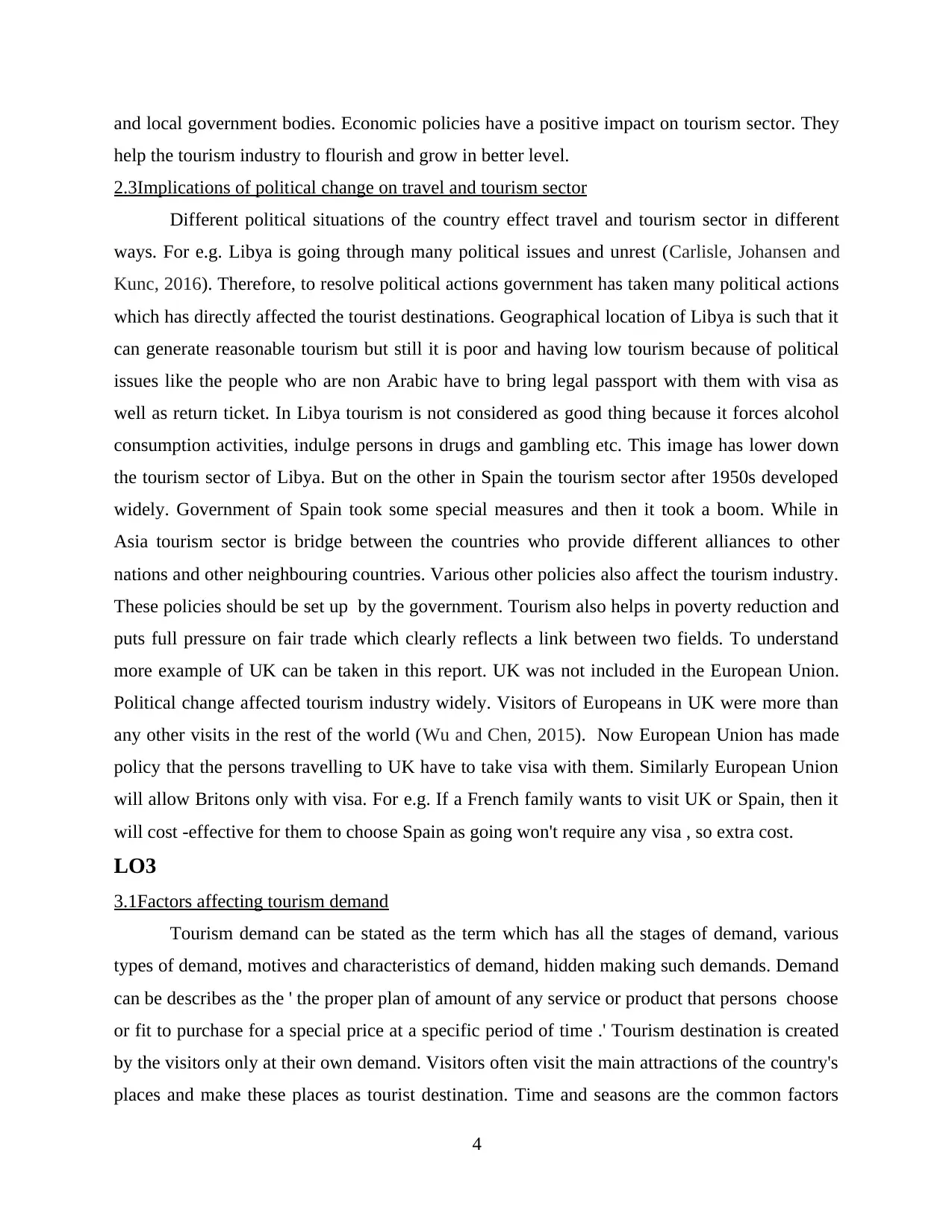
and local government bodies. Economic policies have a positive impact on tourism sector. They
help the tourism industry to flourish and grow in better level.
2.3Implications of political change on travel and tourism sector
Different political situations of the country effect travel and tourism sector in different
ways. For e.g. Libya is going through many political issues and unrest (Carlisle, Johansen and
Kunc, 2016). Therefore, to resolve political actions government has taken many political actions
which has directly affected the tourist destinations. Geographical location of Libya is such that it
can generate reasonable tourism but still it is poor and having low tourism because of political
issues like the people who are non Arabic have to bring legal passport with them with visa as
well as return ticket. In Libya tourism is not considered as good thing because it forces alcohol
consumption activities, indulge persons in drugs and gambling etc. This image has lower down
the tourism sector of Libya. But on the other in Spain the tourism sector after 1950s developed
widely. Government of Spain took some special measures and then it took a boom. While in
Asia tourism sector is bridge between the countries who provide different alliances to other
nations and other neighbouring countries. Various other policies also affect the tourism industry.
These policies should be set up by the government. Tourism also helps in poverty reduction and
puts full pressure on fair trade which clearly reflects a link between two fields. To understand
more example of UK can be taken in this report. UK was not included in the European Union.
Political change affected tourism industry widely. Visitors of Europeans in UK were more than
any other visits in the rest of the world (Wu and Chen, 2015). Now European Union has made
policy that the persons travelling to UK have to take visa with them. Similarly European Union
will allow Britons only with visa. For e.g. If a French family wants to visit UK or Spain, then it
will cost -effective for them to choose Spain as going won't require any visa , so extra cost.
LO3
3.1Factors affecting tourism demand
Tourism demand can be stated as the term which has all the stages of demand, various
types of demand, motives and characteristics of demand, hidden making such demands. Demand
can be describes as the ' the proper plan of amount of any service or product that persons choose
or fit to purchase for a special price at a specific period of time .' Tourism destination is created
by the visitors only at their own demand. Visitors often visit the main attractions of the country's
places and make these places as tourist destination. Time and seasons are the common factors
4
help the tourism industry to flourish and grow in better level.
2.3Implications of political change on travel and tourism sector
Different political situations of the country effect travel and tourism sector in different
ways. For e.g. Libya is going through many political issues and unrest (Carlisle, Johansen and
Kunc, 2016). Therefore, to resolve political actions government has taken many political actions
which has directly affected the tourist destinations. Geographical location of Libya is such that it
can generate reasonable tourism but still it is poor and having low tourism because of political
issues like the people who are non Arabic have to bring legal passport with them with visa as
well as return ticket. In Libya tourism is not considered as good thing because it forces alcohol
consumption activities, indulge persons in drugs and gambling etc. This image has lower down
the tourism sector of Libya. But on the other in Spain the tourism sector after 1950s developed
widely. Government of Spain took some special measures and then it took a boom. While in
Asia tourism sector is bridge between the countries who provide different alliances to other
nations and other neighbouring countries. Various other policies also affect the tourism industry.
These policies should be set up by the government. Tourism also helps in poverty reduction and
puts full pressure on fair trade which clearly reflects a link between two fields. To understand
more example of UK can be taken in this report. UK was not included in the European Union.
Political change affected tourism industry widely. Visitors of Europeans in UK were more than
any other visits in the rest of the world (Wu and Chen, 2015). Now European Union has made
policy that the persons travelling to UK have to take visa with them. Similarly European Union
will allow Britons only with visa. For e.g. If a French family wants to visit UK or Spain, then it
will cost -effective for them to choose Spain as going won't require any visa , so extra cost.
LO3
3.1Factors affecting tourism demand
Tourism demand can be stated as the term which has all the stages of demand, various
types of demand, motives and characteristics of demand, hidden making such demands. Demand
can be describes as the ' the proper plan of amount of any service or product that persons choose
or fit to purchase for a special price at a specific period of time .' Tourism destination is created
by the visitors only at their own demand. Visitors often visit the main attractions of the country's
places and make these places as tourist destination. Time and seasons are the common factors
4
⊘ This is a preview!⊘
Do you want full access?
Subscribe today to unlock all pages.

Trusted by 1+ million students worldwide
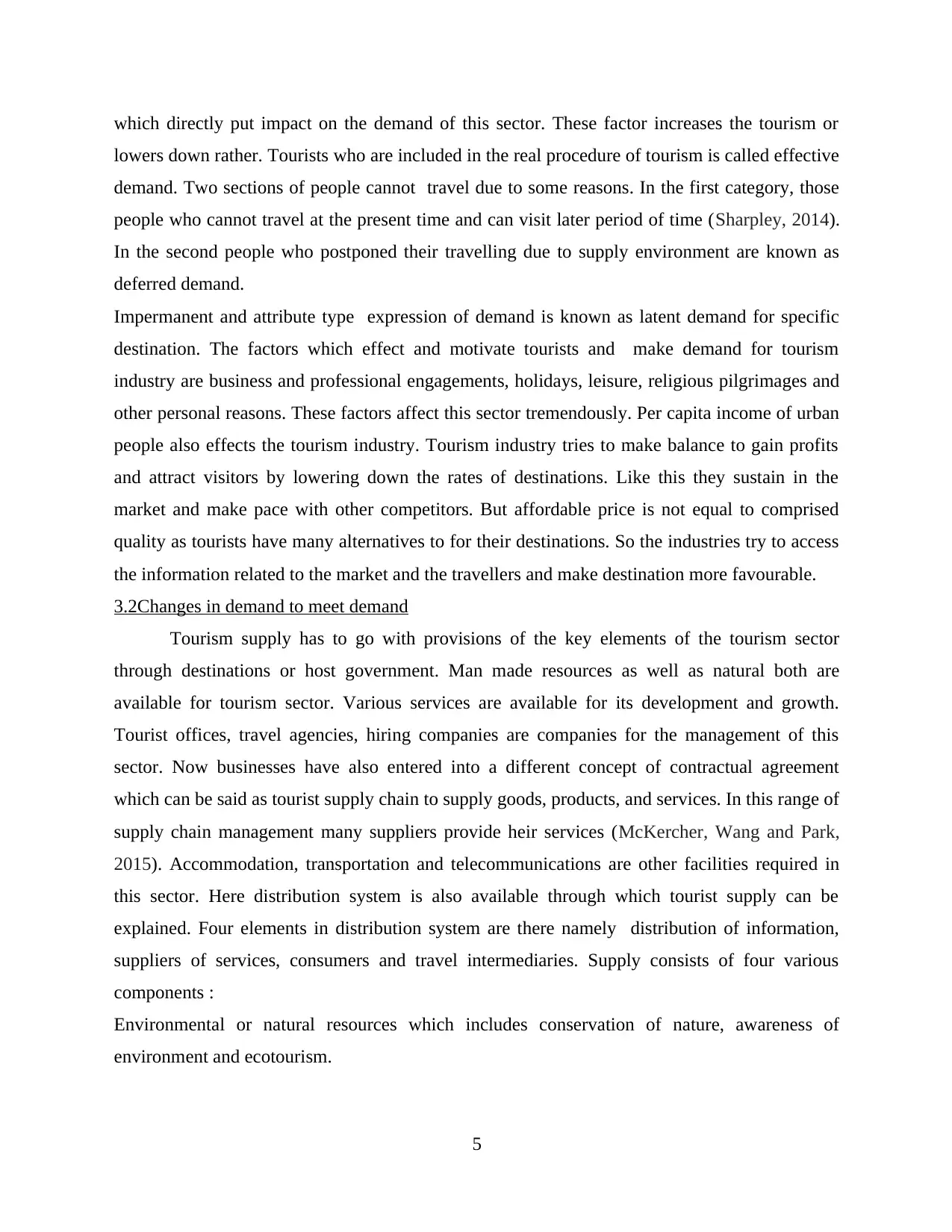
which directly put impact on the demand of this sector. These factor increases the tourism or
lowers down rather. Tourists who are included in the real procedure of tourism is called effective
demand. Two sections of people cannot travel due to some reasons. In the first category, those
people who cannot travel at the present time and can visit later period of time (Sharpley, 2014).
In the second people who postponed their travelling due to supply environment are known as
deferred demand.
Impermanent and attribute type expression of demand is known as latent demand for specific
destination. The factors which effect and motivate tourists and make demand for tourism
industry are business and professional engagements, holidays, leisure, religious pilgrimages and
other personal reasons. These factors affect this sector tremendously. Per capita income of urban
people also effects the tourism industry. Tourism industry tries to make balance to gain profits
and attract visitors by lowering down the rates of destinations. Like this they sustain in the
market and make pace with other competitors. But affordable price is not equal to comprised
quality as tourists have many alternatives to for their destinations. So the industries try to access
the information related to the market and the travellers and make destination more favourable.
3.2Changes in demand to meet demand
Tourism supply has to go with provisions of the key elements of the tourism sector
through destinations or host government. Man made resources as well as natural both are
available for tourism sector. Various services are available for its development and growth.
Tourist offices, travel agencies, hiring companies are companies for the management of this
sector. Now businesses have also entered into a different concept of contractual agreement
which can be said as tourist supply chain to supply goods, products, and services. In this range of
supply chain management many suppliers provide heir services (McKercher, Wang and Park,
2015). Accommodation, transportation and telecommunications are other facilities required in
this sector. Here distribution system is also available through which tourist supply can be
explained. Four elements in distribution system are there namely distribution of information,
suppliers of services, consumers and travel intermediaries. Supply consists of four various
components :
Environmental or natural resources which includes conservation of nature, awareness of
environment and ecotourism.
5
lowers down rather. Tourists who are included in the real procedure of tourism is called effective
demand. Two sections of people cannot travel due to some reasons. In the first category, those
people who cannot travel at the present time and can visit later period of time (Sharpley, 2014).
In the second people who postponed their travelling due to supply environment are known as
deferred demand.
Impermanent and attribute type expression of demand is known as latent demand for specific
destination. The factors which effect and motivate tourists and make demand for tourism
industry are business and professional engagements, holidays, leisure, religious pilgrimages and
other personal reasons. These factors affect this sector tremendously. Per capita income of urban
people also effects the tourism industry. Tourism industry tries to make balance to gain profits
and attract visitors by lowering down the rates of destinations. Like this they sustain in the
market and make pace with other competitors. But affordable price is not equal to comprised
quality as tourists have many alternatives to for their destinations. So the industries try to access
the information related to the market and the travellers and make destination more favourable.
3.2Changes in demand to meet demand
Tourism supply has to go with provisions of the key elements of the tourism sector
through destinations or host government. Man made resources as well as natural both are
available for tourism sector. Various services are available for its development and growth.
Tourist offices, travel agencies, hiring companies are companies for the management of this
sector. Now businesses have also entered into a different concept of contractual agreement
which can be said as tourist supply chain to supply goods, products, and services. In this range of
supply chain management many suppliers provide heir services (McKercher, Wang and Park,
2015). Accommodation, transportation and telecommunications are other facilities required in
this sector. Here distribution system is also available through which tourist supply can be
explained. Four elements in distribution system are there namely distribution of information,
suppliers of services, consumers and travel intermediaries. Supply consists of four various
components :
Environmental or natural resources which includes conservation of nature, awareness of
environment and ecotourism.
5
Paraphrase This Document
Need a fresh take? Get an instant paraphrase of this document with our AI Paraphraser
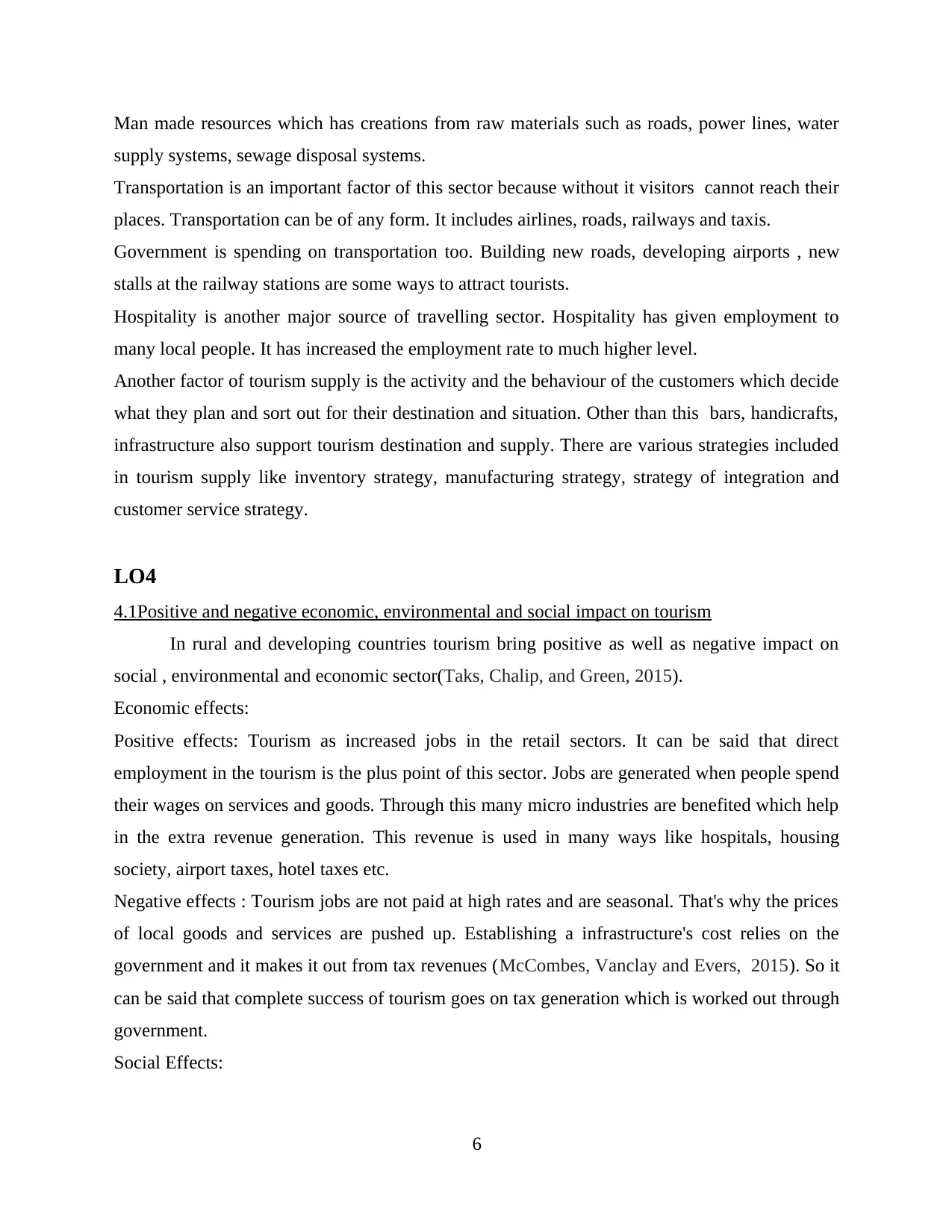
Man made resources which has creations from raw materials such as roads, power lines, water
supply systems, sewage disposal systems.
Transportation is an important factor of this sector because without it visitors cannot reach their
places. Transportation can be of any form. It includes airlines, roads, railways and taxis.
Government is spending on transportation too. Building new roads, developing airports , new
stalls at the railway stations are some ways to attract tourists.
Hospitality is another major source of travelling sector. Hospitality has given employment to
many local people. It has increased the employment rate to much higher level.
Another factor of tourism supply is the activity and the behaviour of the customers which decide
what they plan and sort out for their destination and situation. Other than this bars, handicrafts,
infrastructure also support tourism destination and supply. There are various strategies included
in tourism supply like inventory strategy, manufacturing strategy, strategy of integration and
customer service strategy.
LO4
4.1Positive and negative economic, environmental and social impact on tourism
In rural and developing countries tourism bring positive as well as negative impact on
social , environmental and economic sector(Taks, Chalip, and Green, 2015).
Economic effects:
Positive effects: Tourism as increased jobs in the retail sectors. It can be said that direct
employment in the tourism is the plus point of this sector. Jobs are generated when people spend
their wages on services and goods. Through this many micro industries are benefited which help
in the extra revenue generation. This revenue is used in many ways like hospitals, housing
society, airport taxes, hotel taxes etc.
Negative effects : Tourism jobs are not paid at high rates and are seasonal. That's why the prices
of local goods and services are pushed up. Establishing a infrastructure's cost relies on the
government and it makes it out from tax revenues (McCombes, Vanclay and Evers, 2015). So it
can be said that complete success of tourism goes on tax generation which is worked out through
government.
Social Effects:
6
supply systems, sewage disposal systems.
Transportation is an important factor of this sector because without it visitors cannot reach their
places. Transportation can be of any form. It includes airlines, roads, railways and taxis.
Government is spending on transportation too. Building new roads, developing airports , new
stalls at the railway stations are some ways to attract tourists.
Hospitality is another major source of travelling sector. Hospitality has given employment to
many local people. It has increased the employment rate to much higher level.
Another factor of tourism supply is the activity and the behaviour of the customers which decide
what they plan and sort out for their destination and situation. Other than this bars, handicrafts,
infrastructure also support tourism destination and supply. There are various strategies included
in tourism supply like inventory strategy, manufacturing strategy, strategy of integration and
customer service strategy.
LO4
4.1Positive and negative economic, environmental and social impact on tourism
In rural and developing countries tourism bring positive as well as negative impact on
social , environmental and economic sector(Taks, Chalip, and Green, 2015).
Economic effects:
Positive effects: Tourism as increased jobs in the retail sectors. It can be said that direct
employment in the tourism is the plus point of this sector. Jobs are generated when people spend
their wages on services and goods. Through this many micro industries are benefited which help
in the extra revenue generation. This revenue is used in many ways like hospitals, housing
society, airport taxes, hotel taxes etc.
Negative effects : Tourism jobs are not paid at high rates and are seasonal. That's why the prices
of local goods and services are pushed up. Establishing a infrastructure's cost relies on the
government and it makes it out from tax revenues (McCombes, Vanclay and Evers, 2015). So it
can be said that complete success of tourism goes on tax generation which is worked out through
government.
Social Effects:
6
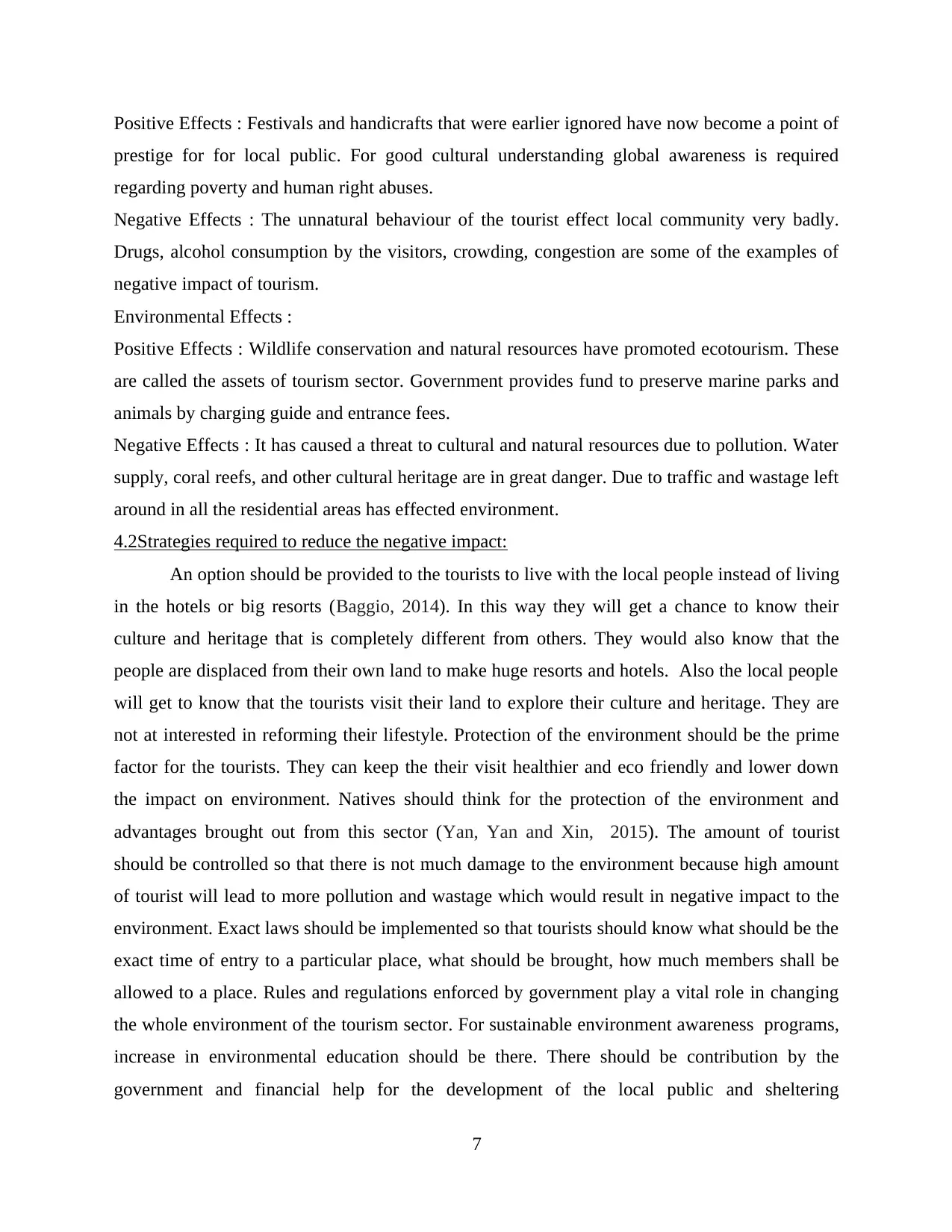
Positive Effects : Festivals and handicrafts that were earlier ignored have now become a point of
prestige for for local public. For good cultural understanding global awareness is required
regarding poverty and human right abuses.
Negative Effects : The unnatural behaviour of the tourist effect local community very badly.
Drugs, alcohol consumption by the visitors, crowding, congestion are some of the examples of
negative impact of tourism.
Environmental Effects :
Positive Effects : Wildlife conservation and natural resources have promoted ecotourism. These
are called the assets of tourism sector. Government provides fund to preserve marine parks and
animals by charging guide and entrance fees.
Negative Effects : It has caused a threat to cultural and natural resources due to pollution. Water
supply, coral reefs, and other cultural heritage are in great danger. Due to traffic and wastage left
around in all the residential areas has effected environment.
4.2Strategies required to reduce the negative impact:
An option should be provided to the tourists to live with the local people instead of living
in the hotels or big resorts (Baggio, 2014). In this way they will get a chance to know their
culture and heritage that is completely different from others. They would also know that the
people are displaced from their own land to make huge resorts and hotels. Also the local people
will get to know that the tourists visit their land to explore their culture and heritage. They are
not at interested in reforming their lifestyle. Protection of the environment should be the prime
factor for the tourists. They can keep the their visit healthier and eco friendly and lower down
the impact on environment. Natives should think for the protection of the environment and
advantages brought out from this sector (Yan, Yan and Xin, 2015). The amount of tourist
should be controlled so that there is not much damage to the environment because high amount
of tourist will lead to more pollution and wastage which would result in negative impact to the
environment. Exact laws should be implemented so that tourists should know what should be the
exact time of entry to a particular place, what should be brought, how much members shall be
allowed to a place. Rules and regulations enforced by government play a vital role in changing
the whole environment of the tourism sector. For sustainable environment awareness programs,
increase in environmental education should be there. There should be contribution by the
government and financial help for the development of the local public and sheltering
7
prestige for for local public. For good cultural understanding global awareness is required
regarding poverty and human right abuses.
Negative Effects : The unnatural behaviour of the tourist effect local community very badly.
Drugs, alcohol consumption by the visitors, crowding, congestion are some of the examples of
negative impact of tourism.
Environmental Effects :
Positive Effects : Wildlife conservation and natural resources have promoted ecotourism. These
are called the assets of tourism sector. Government provides fund to preserve marine parks and
animals by charging guide and entrance fees.
Negative Effects : It has caused a threat to cultural and natural resources due to pollution. Water
supply, coral reefs, and other cultural heritage are in great danger. Due to traffic and wastage left
around in all the residential areas has effected environment.
4.2Strategies required to reduce the negative impact:
An option should be provided to the tourists to live with the local people instead of living
in the hotels or big resorts (Baggio, 2014). In this way they will get a chance to know their
culture and heritage that is completely different from others. They would also know that the
people are displaced from their own land to make huge resorts and hotels. Also the local people
will get to know that the tourists visit their land to explore their culture and heritage. They are
not at interested in reforming their lifestyle. Protection of the environment should be the prime
factor for the tourists. They can keep the their visit healthier and eco friendly and lower down
the impact on environment. Natives should think for the protection of the environment and
advantages brought out from this sector (Yan, Yan and Xin, 2015). The amount of tourist
should be controlled so that there is not much damage to the environment because high amount
of tourist will lead to more pollution and wastage which would result in negative impact to the
environment. Exact laws should be implemented so that tourists should know what should be the
exact time of entry to a particular place, what should be brought, how much members shall be
allowed to a place. Rules and regulations enforced by government play a vital role in changing
the whole environment of the tourism sector. For sustainable environment awareness programs,
increase in environmental education should be there. There should be contribution by the
government and financial help for the development of the local public and sheltering
7
⊘ This is a preview!⊘
Do you want full access?
Subscribe today to unlock all pages.

Trusted by 1+ million students worldwide
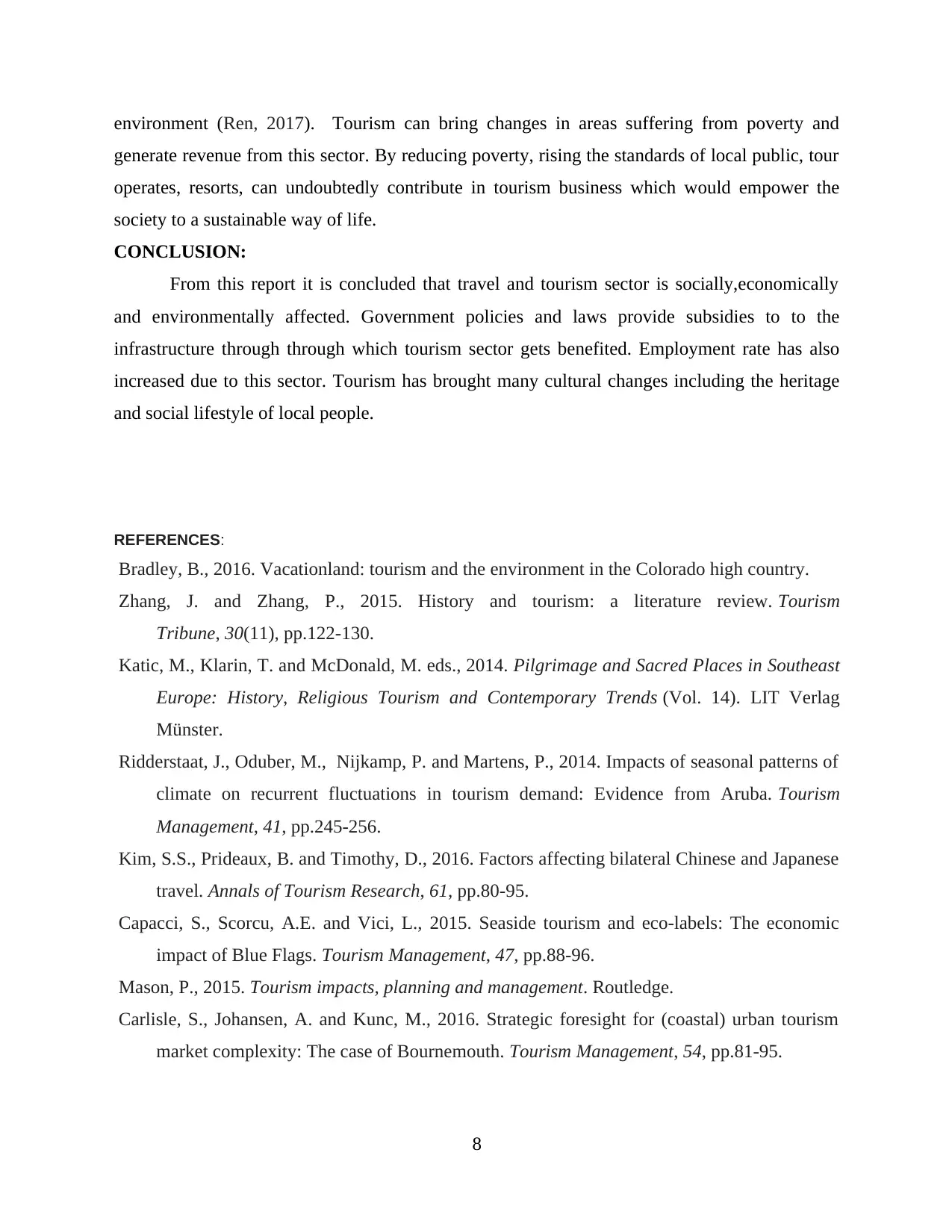
environment (Ren, 2017). Tourism can bring changes in areas suffering from poverty and
generate revenue from this sector. By reducing poverty, rising the standards of local public, tour
operates, resorts, can undoubtedly contribute in tourism business which would empower the
society to a sustainable way of life.
CONCLUSION:
From this report it is concluded that travel and tourism sector is socially,economically
and environmentally affected. Government policies and laws provide subsidies to to the
infrastructure through through which tourism sector gets benefited. Employment rate has also
increased due to this sector. Tourism has brought many cultural changes including the heritage
and social lifestyle of local people.
REFERENCES:
Bradley, B., 2016. Vacationland: tourism and the environment in the Colorado high country.
Zhang, J. and Zhang, P., 2015. History and tourism: a literature review. Tourism
Tribune, 30(11), pp.122-130.
Katic, M., Klarin, T. and McDonald, M. eds., 2014. Pilgrimage and Sacred Places in Southeast
Europe: History, Religious Tourism and Contemporary Trends (Vol. 14). LIT Verlag
Münster.
Ridderstaat, J., Oduber, M., Nijkamp, P. and Martens, P., 2014. Impacts of seasonal patterns of
climate on recurrent fluctuations in tourism demand: Evidence from Aruba. Tourism
Management, 41, pp.245-256.
Kim, S.S., Prideaux, B. and Timothy, D., 2016. Factors affecting bilateral Chinese and Japanese
travel. Annals of Tourism Research, 61, pp.80-95.
Capacci, S., Scorcu, A.E. and Vici, L., 2015. Seaside tourism and eco-labels: The economic
impact of Blue Flags. Tourism Management, 47, pp.88-96.
Mason, P., 2015. Tourism impacts, planning and management. Routledge.
Carlisle, S., Johansen, A. and Kunc, M., 2016. Strategic foresight for (coastal) urban tourism
market complexity: The case of Bournemouth. Tourism Management, 54, pp.81-95.
8
generate revenue from this sector. By reducing poverty, rising the standards of local public, tour
operates, resorts, can undoubtedly contribute in tourism business which would empower the
society to a sustainable way of life.
CONCLUSION:
From this report it is concluded that travel and tourism sector is socially,economically
and environmentally affected. Government policies and laws provide subsidies to to the
infrastructure through through which tourism sector gets benefited. Employment rate has also
increased due to this sector. Tourism has brought many cultural changes including the heritage
and social lifestyle of local people.
REFERENCES:
Bradley, B., 2016. Vacationland: tourism and the environment in the Colorado high country.
Zhang, J. and Zhang, P., 2015. History and tourism: a literature review. Tourism
Tribune, 30(11), pp.122-130.
Katic, M., Klarin, T. and McDonald, M. eds., 2014. Pilgrimage and Sacred Places in Southeast
Europe: History, Religious Tourism and Contemporary Trends (Vol. 14). LIT Verlag
Münster.
Ridderstaat, J., Oduber, M., Nijkamp, P. and Martens, P., 2014. Impacts of seasonal patterns of
climate on recurrent fluctuations in tourism demand: Evidence from Aruba. Tourism
Management, 41, pp.245-256.
Kim, S.S., Prideaux, B. and Timothy, D., 2016. Factors affecting bilateral Chinese and Japanese
travel. Annals of Tourism Research, 61, pp.80-95.
Capacci, S., Scorcu, A.E. and Vici, L., 2015. Seaside tourism and eco-labels: The economic
impact of Blue Flags. Tourism Management, 47, pp.88-96.
Mason, P., 2015. Tourism impacts, planning and management. Routledge.
Carlisle, S., Johansen, A. and Kunc, M., 2016. Strategic foresight for (coastal) urban tourism
market complexity: The case of Bournemouth. Tourism Management, 54, pp.81-95.
8
Paraphrase This Document
Need a fresh take? Get an instant paraphrase of this document with our AI Paraphraser
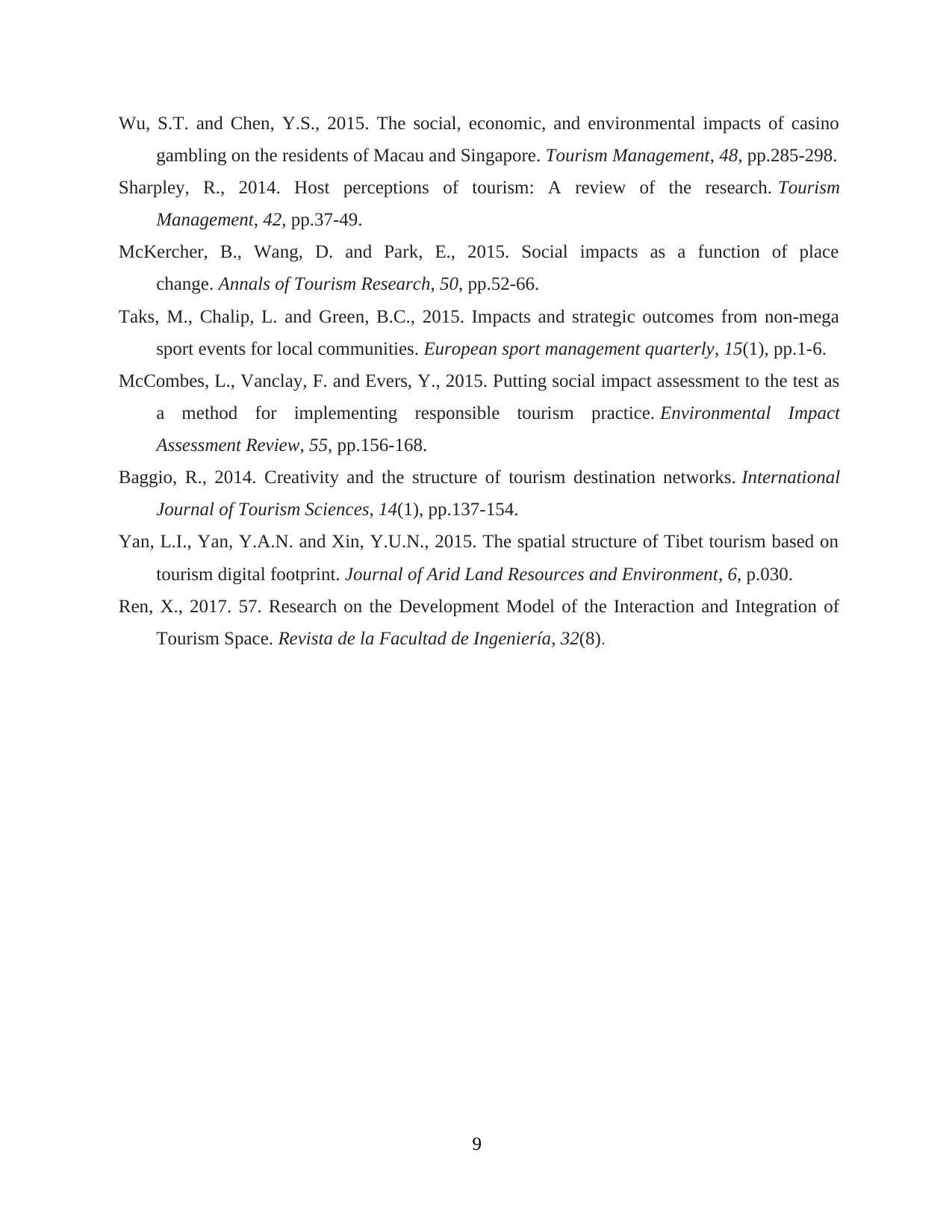
Wu, S.T. and Chen, Y.S., 2015. The social, economic, and environmental impacts of casino
gambling on the residents of Macau and Singapore. Tourism Management, 48, pp.285-298.
Sharpley, R., 2014. Host perceptions of tourism: A review of the research. Tourism
Management, 42, pp.37-49.
McKercher, B., Wang, D. and Park, E., 2015. Social impacts as a function of place
change. Annals of Tourism Research, 50, pp.52-66.
Taks, M., Chalip, L. and Green, B.C., 2015. Impacts and strategic outcomes from non-mega
sport events for local communities. European sport management quarterly, 15(1), pp.1-6.
McCombes, L., Vanclay, F. and Evers, Y., 2015. Putting social impact assessment to the test as
a method for implementing responsible tourism practice. Environmental Impact
Assessment Review, 55, pp.156-168.
Baggio, R., 2014. Creativity and the structure of tourism destination networks. International
Journal of Tourism Sciences, 14(1), pp.137-154.
Yan, L.I., Yan, Y.A.N. and Xin, Y.U.N., 2015. The spatial structure of Tibet tourism based on
tourism digital footprint. Journal of Arid Land Resources and Environment, 6, p.030.
Ren, X., 2017. 57. Research on the Development Model of the Interaction and Integration of
Tourism Space. Revista de la Facultad de Ingeniería, 32(8).
9
gambling on the residents of Macau and Singapore. Tourism Management, 48, pp.285-298.
Sharpley, R., 2014. Host perceptions of tourism: A review of the research. Tourism
Management, 42, pp.37-49.
McKercher, B., Wang, D. and Park, E., 2015. Social impacts as a function of place
change. Annals of Tourism Research, 50, pp.52-66.
Taks, M., Chalip, L. and Green, B.C., 2015. Impacts and strategic outcomes from non-mega
sport events for local communities. European sport management quarterly, 15(1), pp.1-6.
McCombes, L., Vanclay, F. and Evers, Y., 2015. Putting social impact assessment to the test as
a method for implementing responsible tourism practice. Environmental Impact
Assessment Review, 55, pp.156-168.
Baggio, R., 2014. Creativity and the structure of tourism destination networks. International
Journal of Tourism Sciences, 14(1), pp.137-154.
Yan, L.I., Yan, Y.A.N. and Xin, Y.U.N., 2015. The spatial structure of Tibet tourism based on
tourism digital footprint. Journal of Arid Land Resources and Environment, 6, p.030.
Ren, X., 2017. 57. Research on the Development Model of the Interaction and Integration of
Tourism Space. Revista de la Facultad de Ingeniería, 32(8).
9
1 out of 11
Related Documents
Your All-in-One AI-Powered Toolkit for Academic Success.
+13062052269
info@desklib.com
Available 24*7 on WhatsApp / Email
![[object Object]](/_next/static/media/star-bottom.7253800d.svg)
Unlock your academic potential
Copyright © 2020–2025 A2Z Services. All Rights Reserved. Developed and managed by ZUCOL.





